Goldman Sachs warns U.S. growth could weaken as hiring slows and consumers pull back
The bank's warning came after Trump slapped new tariffs on countries across the world and fired an official over the most recent jobs report

Andrew Harnik/Getty Images
The U.S. economy could lose further momentum in the coming quarters, Goldman Sachs has warned, amid the ongoing fallout from last week’s jobs report that showed increasing strain caused by tariffs.
Suggested Reading
Goldman Sachs forecast in a note that final quarter gross domestic product (GDP) is only projected to be 1.1% higher than it was at the same point in 2024, well below the investment bank’s 2% estimate of potential growth.
Related Content
Chief economist Jan Hatzius pointed to flimsy domestic demand with consumer spending, typically the biggest driver of the economy, expected to rise just 0.8% in the second half of the year. Weaker job growth, higher prices from new tariffs, and a planned reduction in government support payments are all expected to weigh on households.
The note comes after President Donald Trump fired Bureau of Labor Statistics Commissioner Erika McEntarfer over the most recent jobs data, which showed that the U.S. economy added 73,000 jobs in July with significant downward revisions for the prior two months.
The data combined to illustrate a flagging economy due to amplified business uncertainty around Trump’s tariffs, which are set to spike into the double digits for most countries next week. Trump claimed without evidence the data was false. “I thought her numbers were wrong," he said shortly after announcing the firing in a social media post.
The Goldman Sachs note suggests the president may need to brace for more poor numbers this year. Business investment is projected to fall at a 0.6% annualized rate, partly reflecting a sharp pullback in equipment spending after earlier front loading ahead of tariff increases.
Investment will also see “a drag from policy uncertainty and concerns about the economic outlook,” wrote Hatzius.
While spending by consumers and businesses is expected to stay subdued, overall GDP could get a short-term lift from companies restocking their inventories and a smaller trade deficit, the note said.
Goldman Sachs expects the trade gap to shrink from 3.1% of GDP at the end of 2024 to 2.4% by the end of 2025. That’s because high tariffs are likely to cut down on imports, while a weaker dollar and limited retaliation from other countries help support U.S. exports.
—Joseph Zeballos-Roig contributed to this article.
